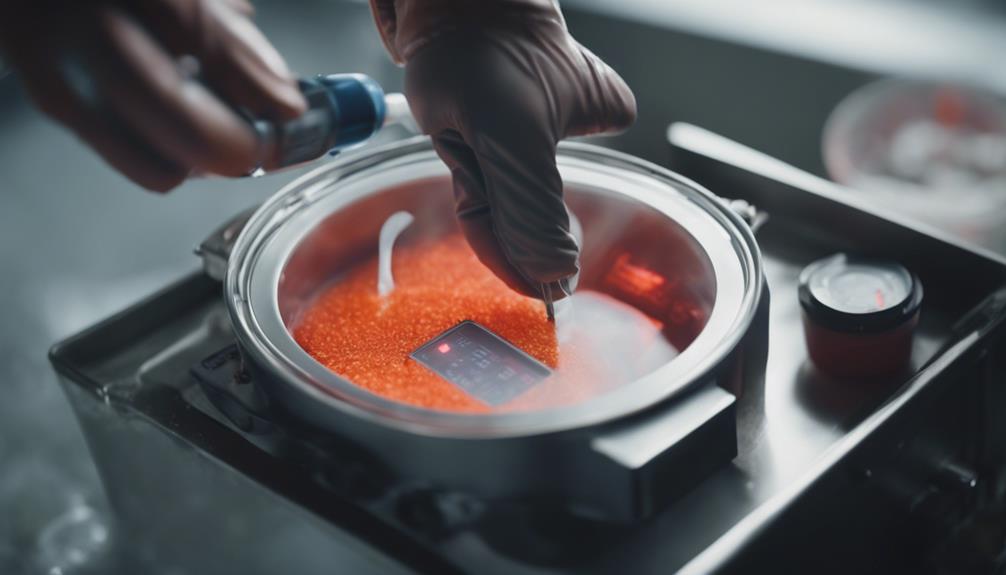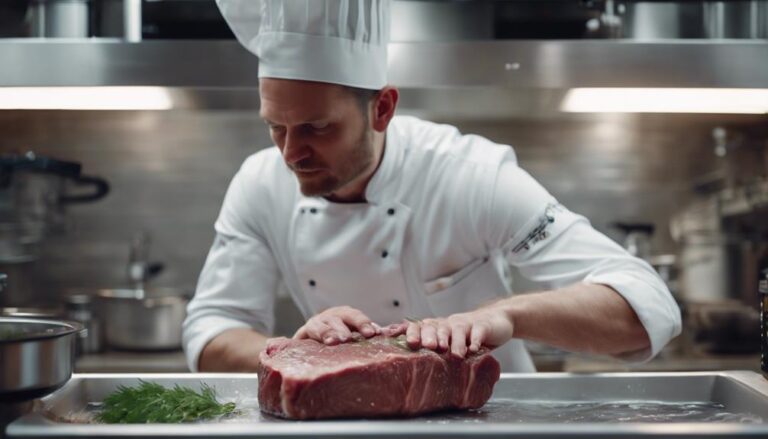3 Best Safety Guidelines for Sous Vide Cooking
Guarantee precise cooking temperatures by cooking above 130F to eliminate bacteria. Keep meat out of the danger zone temperature range. Practice thorough hand washing and sanitize utensils to prevent contamination. Refrigerate promptly to uphold food safety. Regularly calibrate your sous vide circulator for accurate temperature control. Verify temperature with a thermometer for safety. Set your circulator slightly above the recipe temperature. Maintaining equipment prevents undercooking. Double-check with a thermometer for accurate temperature readings. Master these guidelines for a safe sous vide experience. Explore further to enhance your cooking skills.
What You Will Learn Here
- Cook food above 130F (54.4C) to kill bacteria effectively.
- Practice thorough hand washing and sanitize surfaces to prevent contamination.
- Maintain and calibrate sous vide circulator for precise temperature control.
- Refrigerate leftovers promptly to maintain safety and quality.
- Set circulator slightly above recipe temperature to ensure thorough cooking.
Importance of Proper Cooking Temperatures
Understanding the significance of precise cooking temperatures is essential when utilizing sous vide cooking methods to guarantee food safety. In sous vide cooking, cooking below 130F (54.4C) is critical in killing bacteria, allowing pathogenic bacteria to thrive between 40F (4.4C) and 126F (52.2C) in the danger zone.
For extended cooks, it's important to confirm meat is cooked at least at 130F (54.4C) to eliminate any harmful bacteria present. To enhance safety, it's recommended to cook a degree or two above the danger zone temperature for longer durations.
Always verify the accuracy of the circulator temperature regularly using a second thermometer to verify that the food is being cooked at the proper temperature to prevent any risks associated with undercooking.
Significance of Food Handling Practices
To guarantee safe sous vide cooking, proper food handling practices play a pivotal role in minimizing the risk of contamination and ensuring food safety. When handling sous vide food, following these guidelines is essential:
- Thorough Hand Washing: Before you cook sous vide, make sure to wash your hands thoroughly. This simple step reduces the risk of contamination and helps maintain food safety standards.
- Sanitizing Surfaces and Utensils: To prevent the spread of harmful bacteria, sanitize all surfaces and utensils that come into contact with sous vide food. This practice is critical for maintaining a safe cooking environment.
- Proper Storage and Chilling: Properly storing and chilling food after cooking is vital to prevent bacterial growth and food spoilage. Ensure that leftovers are promptly refrigerated to maintain their quality and safety.
Essential Equipment Maintenance for Safety

Regularly checking and calibrating your sous vide circulator is essential for maintaining precise temperature control and ensuring safe cooking practices. To guarantee accurate temperature control when cooking sous vide, it's vital to verify the circulator's temperature accuracy using a thermometer. Set your circulator slightly above the recipe temperature to account for heat loss and secure thorough cooking, especially for longer cooking times.
Proper maintenance of your sous vide circulator is paramount to prevent undercooking and guarantee food safety. Regular circulator calibration is necessary to uphold ideal temperature settings. Double-check the circulator's temperature with a thermometer to mitigate any risks of bacterial growth due to inaccurate readings. By adhering to these maintenance practices, you can uphold accurate temperature control, reduce food safety concerns, and deliver consistently well-prepared sous vide dishes. Remember, a well-maintained circulator is key to safe and delicious sous vide cooking.
Frequently Asked Questions
What Are the FDA Guidelines for Sous Vide?
When sous vide cooking, keep in mind the FDA guidelines: accurate temperature control for pasteurization, proper cooking times, and sealed sous vide bags for food safety. Your attention to detail guarantees pathogen elimination and a delicious meal.
What Is the Safety of Sous Vide Cooking?
Ensuring the safety of sous vide cooking involves precise temperature control, monitoring food safety, following cooking times, utilizing vacuum sealing, pasteurizing, ensuring water circulation, distributing heat evenly, using proper equipment, storing food correctly, and monitoring temperatures consistently.
How Do You Use Sous Vide Safely?
Guarantee safety when using sous vide by controlling temperature, handling food properly, maintaining equipment, respecting time limits, sealing bags, understanding pasteurization, managing water circulation, cooling effectively, preventing cross-contamination, and using suitable sous vide bags.
Can Bacteria Grow in Sous Vide?
Bacteria risk is a concern in sous vide cooking due to temperature fluctuations. Proper temperature control, pasteurization process, and monitoring cooking times are essential for food safety. Guarantee proper sealing, use correct sous vide equipment, and prevent contamination.
Conclusion
Remember, following safety guidelines is crucial when cooking sous vide.
Always make sure you're cooking at the correct temperatures, handle food with care, and regularly maintain your equipment.
By taking these precautions, you can enjoy delicious sous vide meals while keeping yourself and your loved ones safe from foodborne illnesses.
Happy cooking!









